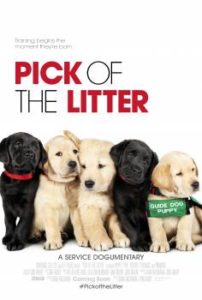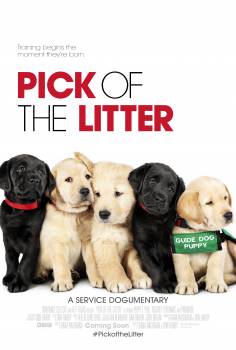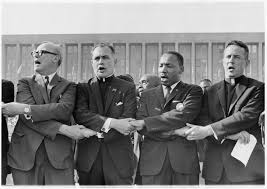Pick of the Litter Directors on Five Adorable Puppies Training to be Guide Dogs
Posted on September 12, 2018 at 9:31 am
Pick of the Litter was one of the highlights of Washington DC’s AFIDocs documentary film festival. It follows five puppy siblings, all with names beginning with P, as they go through the extensive training and rigorous tests over two years to become guide dogs for the blind. Only a fraction of the dogs bred for the program have the temperament and skills for the job. We follow Patriot, Poppet, Primrose, Phil, and Potomac from birth to their ultimate place in a film that is exciting, funny, and always heartwarming.

In an interview, directors Dana Nachman and Don Hardy, Jr. revealed their own favorites and described some of the behind the scenes choices and challenges.
Before we even meet the puppies, we get to hear from people whose lives have been saved by guide dogs. Why did you want to start with that?
DH: It’s really a life and death thing and what these dogs do is really extraordinary. So if you start there, then you can go back to the little bundles of fur and the people.
DN: It was very important to us to show what was at stake before we get to the cuteness of the puppies. It is essential to set that tone.
Your camera work was really impressive. At some points you had us at dog level. And for some essential conversations, you had us at both ends of the phone calls.
DH: It’s something we talked about from the very beginning, trying to tell it from that point of view of the dog. So we’re on the ground a lot. We’re trying to just stay in that world.
DN: Typically you see a lot of dog stuff just shooting down at the dog and we just didn’t want that. It really diminishes them if you’re coming from the upper angle whereas if you’re down low then you’re in their world and experiencing it like they do.
DH: We started with the big shoulder mount camera that is typical. It was fine when the dogs were small and didn’t move a lot but then once they got big they got faster. And they train the dogs really fast. There was no way to keep up. So we developed this little steadicam-like system, a small camera on a gimbal. And then I plug that into a monopod so then I could swing it down very low to get the dog’s eye level and then go up really high to to almost look like a drone.
And they’re inexpensive cameras so we ended up with a couple of them and so for a few key sequences Dana was shooting too. It just would all pair together well but it was a big undertaking to make this thing look like cohesive.
So much of the training of the dogs has to do with focusing their attention and not letting them get distracted. How did you get all the footage you needed without getting in their way?
DH: That was a big concern early on and we thought it would be maybe prevent Guide Dogs for the Blind from allowing us the access that we needed. We’re always going to be in the way. So that was another reason we had to develop this lightweight camera system to be able to not interrupt anything; there was no stopping to say, “Can you do that again?” We just had to keep up. But their response is interesting. They said that we’re just another distraction that these dogs have to deal with and it’s just part of life. We did a lot of the shooting ourselves so they just got to know us and I think we were just part of the training in a way.
DN: At one point one of the dogs was really tanking in some of his tasks like he wasn’t doing well and that particular dog liked Don a lot and so I think we even felt more nervous. We wanted to hang back because we didn’t want him to be out on our account. But they said, “If he can’t deal with Don being there then what’s he not going to be able to deal with if he’s with a visually impaired person?”
DH: It’s important in whatever story you’re telling to remember that the life the real events going on is more important than you.
How did you get started on this story?
DH: We worked together at the NBC station in San Francisco. We were both dog lovers and we did several pieces together on Guide Dogs for the Blind and so we always knew that they were just the tip of the iceberg. Pretty much coincidentally my mom was a newspaper reporter and she did a series in New York following a litter from birth until if they made it. We were like, “Oh well it’s great for a newspaper but so much better if it’s on camera.”
The dogs are wonderful, but the people are pretty wonderful, too, so dedicated and kind. I love their euphemism for the dogs who don’t make it all the way through the program: career changed.
DN: And some of the best parts in this film. They take it all very seriously. It’s almost a quasi Best in Show. It’s not even that you’re making fun of that. They own it. It is an earnestness that really resonates with me.
Did you each have a favorite? Were you sad for the dogs who were “career changed?”
DN: I’m #teampatriot.
Me, too!
DH: I’m #teamphil. They really say and it turns out to be true that the dogs choose. If you think of it that all of these dogs are doctors but only a few of them can be brain surgeons. They’re all like very incredible animals but only a few can do this job which is has life and death stakes.
DN: And I hope one of the things that people take away from the film too is that anybody who has a dog or has had a dog — it is a profound relationship. Even just for a regular person who has nothing wrong with them per se, it really is a life-changing relationship and we all know that.


